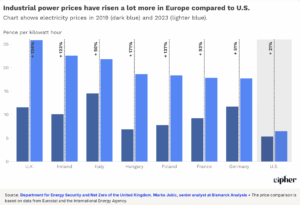President Xi of China promised to reduce its greenhouse gas emissions by seven to 10% of its peak over the next decade. While that reduction is far less than what some experts say is needed, which is a 30% reduction, the commitment from the world’s largest carbon emitter could potentially strengthen China’s global lead in producing electric vehicles and solar panels. That may be why Xi is making the commitment. China’s previous climate commitments to the United Nations were to bring emissions to a peak before 2030 and to net zero by 2060. However, according to Reuters, it is well behind on its interim goal to cut energy intensity by 13.5% and carbon intensity by 18% between 2021 and 2025. Intensity rates indicate the amount of energy consumed and carbon dioxide emitted for each unit of economic growth.
According to the BBC, China’s recent commitments include: expanding wind and solar power capacity to more than six times 2020 levels, increasing forest stocks to more than 24 billion cubic meters, and making “new energy vehicles” the mainstream in new vehicle sales. It exceeded its past commitment to reach a capacity of 1,200 gigawatts for wind and solar power by 2030, which it reached six years early in 2024. Wind and solar capacity, however, is not equivalent to fossil fuel or nuclear capacity in that it produces only a quarter or a third of the energy of conventional fuels. Furthermore, while China was building solar and wind capacity, it was also building coal capacity, which can operate for four, five, or six decades. In contrast, wind and solar units operate for a mere 20 years, and some have not even lasted that long. Last year, China’s electricity generation from coal hit a new record of 5828 terawatt hours — over eight times higher than the electricity generation produced from coal in the United States.
In a video statement to the United Nations in New York, President Xi Jinping said, “Green and low carbon transition is the trend of our time,” and added, “some countries are against it.” His comments were in stark contrast to those of President Trump, who warned world leaders at the U.N. meeting, “I’m telling you that if you don’t get away from the green energy scam, your country is going to fail.” President Trump promoted U.S. fossil fuels and urged world leaders, particularly those in Europe, to abandon wind projects in favor of increased oil and gas drilling.
U.S Department of Energy Secretary Chris Wright also urged countries to follow Washington in withdrawing from the Paris Agreement. He called the treaty’s supporters “a club of people that have lost sight of the interests of their own people.” Secretary Wright and Interior Secretary Doug Burgum have toured Europe to secure contracts to sell more American oil and natural gas and lobby the European Union to loosen environmental regulations. Via the New York Times, as part of the E.U.’s trade deal with the Trump administration, it agreed to purchase $750 billion of American energy, mostly oil and gas, over the course of President Trump’s term in office. Secretary Wright also said that President Trump deserved a “hero of the climate award.”
Europe’s transition to “clean” energy has resulted in skyrocketing energy prices, far higher than those in the United States. Their green policies have caused energy prices to rise two to three times faster in Germany and other Eurozone nations than in America (see chart below).

China’s 2025 Climate Commitments and Targets in the Energy Sector
Few people realize that policies to mitigate greenhouse gas emissions eat into the hands of China, which is endowed with few oil and gas resources compared to the United States, but has invested in minerals needed for “clean” technologies that make the United States and Europe dependent upon them. The Chinese have spent decades preparing for the West’s energy transition to renewable energy and electric vehicles, and it will take the West decades to catch up. In the meantime, China will be selling its comparably inexpensive electric vehicles, solar panels, and other “green” technologies to Western countries, increasing its economic growth and the wealth of its citizenry.
The World Relies on Fossil Fuels
As reported by Visual Capitalist, last year, fossil fuels supplied 86.7% of global energy needs, led by oil with a 33.6% share, followed by coal with a 27.9% share, and natural gas with a 25.2% share. Global energy demand increased 2% to reach an all-time high of 592 exajoules in 2024. Non-fossil fuels grew 7%, bringing their share of the global energy mix to 13.5%.
Analysis
For too long, climate politics have allowed China to gain a rhetorical advantage over Western countries due to its heavy investment in “green” energy technologies and electric vehicles, allowing the country to appear supportive of a global energy transition while it continues to build coal plants that last for decades. The Trump administration has done a commendable job fighting this narrative, recognizing that reducing carbon emissions and achieving environmental progress have more to do with building wealth through investment in reliable energy than forgoing growth to reorient the economy around “green” energy. As we point out in Breathe a Little Easier: Why America’s Air Is Among the Cleanest in the World, “Rather than constraining further economic development we ought to champion the institutions that enable it while respecting environmental quality as well—namely, property rights and the market process.”
For inquiries, please contact wrampe@ierdc.org.